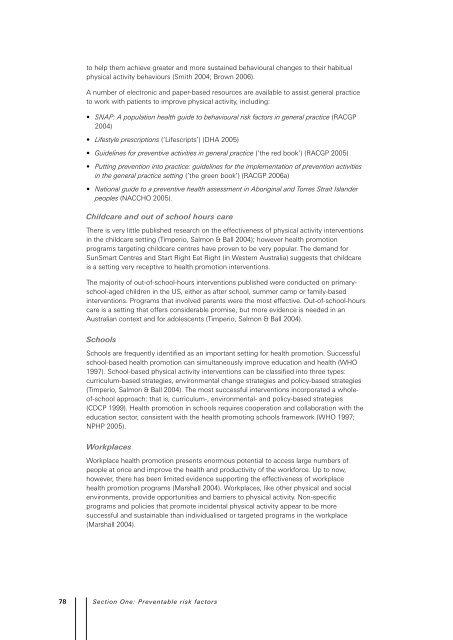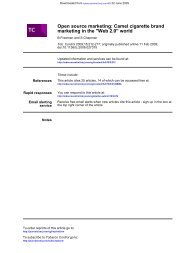National Cancer Prevention Policy - Tobacco Control Supersite
National Cancer Prevention Policy - Tobacco Control Supersite
National Cancer Prevention Policy - Tobacco Control Supersite
Create successful ePaper yourself
Turn your PDF publications into a flip-book with our unique Google optimized e-Paper software.
to help them achieve greater and more sustained behavioural changes to their habitual<br />
physical activity behaviours (Smith 2004; Brown 2006).<br />
A number of electronic and paper-based resources are available to assist general practice<br />
to work with patients to improve physical activity, including:<br />
•<br />
•<br />
•<br />
•<br />
•<br />
SNAP: A population health guide to behavioural risk factors in general practice (RACGP<br />
2004)<br />
Lifestyle prescriptions (‘Lifescripts’) (DHA 2005)<br />
Guidelines for preventive activities in general practice (‘the red book’) (RACGP 2005)<br />
Putting prevention into practice: guidelines for the implementation of prevention activities<br />
in the general practice setting (‘the green book’) (RACGP 2006a)<br />
<strong>National</strong> guide to a preventive health assessment in Aboriginal and Torres Strait Islander<br />
peoples (NACCHO 2005).<br />
Childcare and out of school hours care<br />
There is very little published research on the effectiveness of physical activity interventions<br />
in the childcare setting (Timperio, Salmon & Ball 2004); however health promotion<br />
programs targeting childcare centres have proven to be very popular. The demand for<br />
SunSmart Centres and Start Right Eat Right (in Western Australia) suggests that childcare<br />
is a setting very receptive to health promotion interventions.<br />
The majority of out-of-school-hours interventions published were conducted on primaryschool-aged<br />
children in the US, either as after school, summer camp or family-based<br />
interventions. Programs that involved parents were the most effective. Out-of-school-hours<br />
care is a setting that offers considerable promise, but more evidence is needed in an<br />
Australian context and for adolescents (Timperio, Salmon & Ball 2004).<br />
Schools<br />
Schools are frequently identified as an important setting for health promotion. Successful<br />
school-based health promotion can simultaneously improve education and health (WHO<br />
1997). School-based physical activity interventions can be classified into three types:<br />
curriculum-based strategies, environmental change strategies and policy-based strategies<br />
(Timperio, Salmon & Ball 2004). The most successful interventions incorporated a wholeof-school<br />
approach: that is, curriculum-, environmental- and policy-based strategies<br />
(CDCP 1999). Health promotion in schools requires cooperation and collaboration with the<br />
education sector, consistent with the health promoting schools framework (WHO 1997;<br />
NPHP 2005).<br />
Workplaces<br />
Workplace health promotion presents enormous potential to access large numbers of<br />
people at once and improve the health and productivity of the workforce. Up to now,<br />
however, there has been limited evidence supporting the effectiveness of workplace<br />
health promotion programs (Marshall 2004). Workplaces, like other physical and social<br />
environments, provide opportunities and barriers to physical activity. Non-specific<br />
programs and policies that promote incidental physical activity appear to be more<br />
successful and sustainable than individualised or targeted programs in the workplace<br />
(Marshall 2004).<br />
Section One: Preventable risk factors




